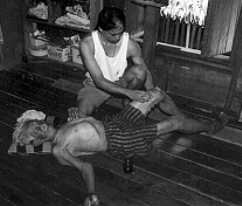The Healing Arts of the Philippines
By Virgil J. Mayor Apostol
continued

Virgil manipulates the urat to increase the flow of blood and spiritual energy
As the natives migrated into the three major islands - Luzon, Visayas, and Mindanao, with them came their animistic beliefs and customs. Assimilated through migration and trade was the influence of Hindu-Malayan and Islamic-Malayan cultures via the islands to the south, as well as the European influence of Spanish conquest, a domain that lasted over 300 years since the 16th century.
Thus, practices from a conglomeration of sciences, religions, arts, and medical practices, are still evident throughout the islands to this present day.
Most prevalent, though, is a spiritualism overseeing the etymology or diagnosis of an illness to the actual healing.
On a metaphysical level, sickness may be caused by several factors including disturbed spirits which dwell in animate or inanimate objects, nakadalapus - when one has accidentally walked through or met with a bad spirit, or even when cutting down a tree without asking permission of the spirit dweller.
In such cases, an animistic ritual offering (atang) along with a prayer or Latin oracion (kararag or incantation) is a possible solution. For healers versed in the physical arts, massage is also initiated to drive away any spirit that has lodged itself in the etheric level of its victim. By driving away the bad spirit, the sickness will go away.
From the metaphysical to the physical level, an indigenous concept of a hot-cold syndrome plays an important role in how nature affects the human organism.
For example, after one has worked hard in the fields, or any type of strenuous activity, the body is understood to be hot. But one who takes a cold bath shortly after, throws off the physiological state that the body is in, plunging it abruptly from hot to cold. From this point, the body becomes susceptible to illness.
The healer advises the patient not to bathe after a treatment because the body has undergone a similar process of working hard. The patient also needs time to regulate the temperature and spiritual energies through the transitory state that the body is undergoing.
Likewise, the healer allows his or her hands and body to rest before washing or else the same effect might occur. But if it is found necessary to wash, heated water, slightly warmer than body temperature, is used.
The concept of a hot-cold syndrome is found in the Philippines, as well as other Southeast Asian countries. For example, a humid condition opens up the pores and causes the body to sweat.
Wind (angin) then blows on the body and cools the sweat, its coldness transferring into the body. If not attended to, a disruption of the natural internal balance occurs; the vigor is weakened, thus causing the body to become susceptible to sickness. This is why parents make sure their children are kept dry and covered, especially if there is a breeze since the pores are still considered open.
The hot-cold syndrome plays an important role in other aspects as well such as in diet, emotions, relationships, etc.There also exists an ancient science and theoretical counterpart to the metaphysical level of sickness. The belief in spiritual energetic channels, called urat and pennet sets the foundation of how massage practices in the Philippines evolved.
Continue




